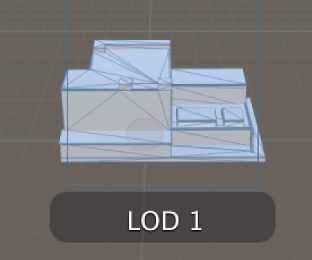- Unity User Manual (2017.4)
- Графика
- Обзор графических возможностей
- Расширенные возможности рендеринга
- Level of Detail (LOD)
Level of Detail (LOD)
When a GameObject in the scene is a long way from the camera, the amount of detail that can be seen on it is greatly reduced. However, the same number of triangles will be used to render the object, even though the detail will not be noticed. An optimisation technique called Level Of Detail (LOD) rendering allows you to reduce the number of triangles rendered for an object as its distance from the camera increases. As long as your objects aren’t all close to the camera at the same time, LOD will reduce the load on the hardware and improve rendering performance.
Для настройки LOD отрисовки объекта в Unity, вы можете добавить на него компонент LOD Group. Более подробно с этим компонентом вы можете ознакомиться на странице со справкой по нему, однако, на изображениях, представленных ниже, вы можете ознакомиться с тем, как меняется уровень LOD (LOD Level) объекта при удалении от камеры. На первом изображении показан объект с уровнем LOD 0 (наиболее детализированный):-

… и на втором изображении показан объект со меньшим уровнем LOD при удалении от камеры:-

Хоть расположение уровней LOD и зависит от целевой платформы и доступных GPU ресурсов, Unity позволяет установить максимальный уровень LOD (Maximum LOD Level) и смещение LOD (LOD Bias, т.е. какому из соседних уровней отдавать предпочтение при расположении между ними) в Quality Settings.
Соглашение об именовании LOD в импортируемых объектах
If you create a set of meshes with names ending in _LOD0, _LOD1, _LOD2, etc, for as many LOD levels as you like, a LOD group for the object with appropriate settings will be created for you automatically on import. For example, if the base name for your mesh is Player, you could create files called Player_LOD0, Player_LOD1 and Player_LOD2 to generate an object with three LOD levels. The numbering convention assumes that LOD 0 is the most detailed model and increasing numbers correspond to decreasing detail.